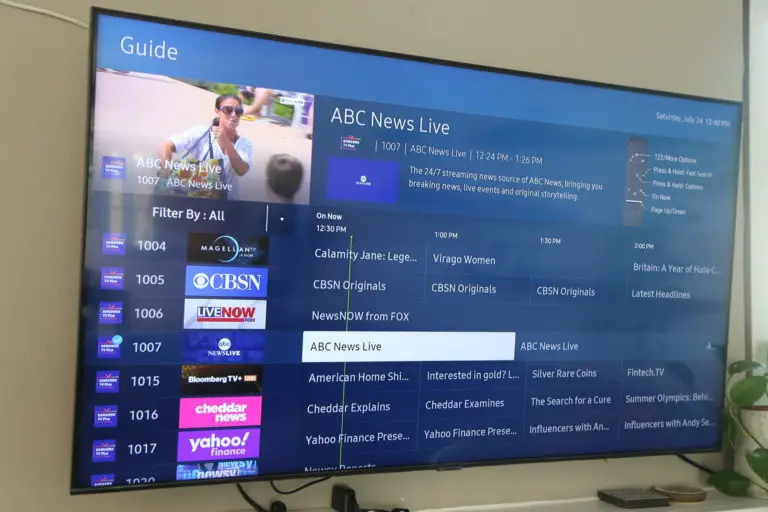What’s Inside a Mohu Leaf Antenna?

If you follow my site, you know that I’m a big fan of the Mohu Leaf flat indoor antenna. It gives me over one hundred channels here in Los Angeles.
One day, reader Philip asked me what was inside the Mohu Leaf antenna. Hmmm, good question!
From all of my antenna testing, I happened to have an old Mohu Leaf Plus. This is an older amplified version of the Mohu Leaf. It’s ideal for a tear down because it was made of laminated paper instead of all plastic like they are now.
The Tear Down
The first thing I did was disassemble the module that attaches the cable to the antenna. This was held together with four custom screws.

Upon opening it, I was surprised to find a small printed circuit board! At first, I thought this was just a passive filter, but later I realized this was the actual amplifier, placed right against the antenna where it should be!

Remember, I disassembled the amplified Mohu Leaf. The regular Mohu Leaf does not have this circuit board or the power module (just a passive balun), see below.

Power is supplied from the USB power module further down the cable. There are only two signal wires, so power is sent through these wires to power the amplifier at the antenna and the signal comes down these same wires via DC blocking capacitors.

The Antenna
Now for the part you’ve probably been waiting for. What does the Mohu Leaf antenna actually look like?
Since this was the older laminated version of the antenna, I could simply cut around the edges and split it open. The center of this antenna two sheets of paper stock with very thin foil for the antenna in between. Unfortunately, it was nearly impossible to peel the paper away from the antenna foil – they were glued tightly together, probably to hide the design.

But, you can see the faint outline of two bowtie antennas. I’ve outlined them below for clarity.

This type of antenna is known as a wide-band printed bowtie antenna. This is a traditional TV antenna style, although the dimensions were carefully chosen by Mohu for optimum reception.
A Comparison
Just to compare, here’s a photo of a Winegard FlatWave Amped antenna. It’s clear so you can easily see the design:

So, not all flat antennas are created equal.
Conclusion
So there you have it! The original Mohu Leaf is a dual wide band printed bowtie antenna!
The current all-plastic Mohu Leaf antenna is much harder to dissect. I’ve get very similar reception with it, so I would assume it’s also a bowtie antenna, but that is just conjecture.
Was that a bit anticlimactic? Were you expecting a more exotic antenna design, perhaps a fractal antenna? Even though the design is very traditional, the Leaf is a great performer, probably due to subtle design tweaks by Mohu. Sometimes it’s best to go back to the basics! – Brian
Keep in Touch – Subscribe for Free
If you liked this article, please sign up for email updates. I’ll send you a note when I publish a new article, no more than once every few months. Unsubscribe any time. – Brian








so the amplified version will get better reception?
Hi Doggiemama5,
Not necessarily. In fact, several readers have reported to me that they got worse reception when using an amplifier (I’ve seen this myself too). Unfortunately, experimentation (trial and error) is the only real way to know whether an amplifier will help, although if you are far from the transmitters or have long cable runs, it’s more likely that an amp will help.
Best,
Brian
Excellent breakdown of the Mohu Leaf antenna. Thanks Brian. It’s more or less what I expected. A primo design to be sure. The sealed “bow tie” elements bare a striking resemblance to what I’m already working with at home.
https://www.facebook.com/photo.php?fbid=2342843065962048&set=p.2342843065962048&type=3&theater
The little per-amplifier is a great idea, but only if it automatically bypasses itself when the DC power is not applied. And I question the combined phasing of the two bow ties when the output is taken from the bottom of the lead lines instead of the exact center where synchronization is assured across the entire band.
Hi Philip,
Yes, good points!
Best,
Brain
That’s probably a balun in the regular Leaf, not a filter. Thanks for the teardown.
Hi Steve,
Thanks for the correction!
Brian
Thanks for the tear down, I found this helpful. Thank you.
https://www.ersantenna.com/about/
Thank You for The Enlightenment…!